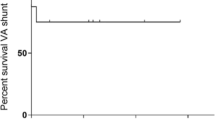Abstract
Purpose
The current surgical management strategies for refractory cases of idiopathic intracranial hypertension (IIH) remain unresolved. We evaluated the outcome of our paediatric patients who were offered a CSF diversion procedure in order to control their symptoms.
Methods
We retrospectively reviewed the medical notes of the patients under 16 years of age, who presented in our centre from 2005 to 2010, with a confirmed diagnosis of IIH, and ultimately had a lumboperitoneal shunt (LPS). We describe their immediate postoperative course, shunt-related complications and recent outcome.
Results
Seven patients presented at a mean age of 8.7 years. Two presented with significant visual loss and had a shunt acutely; the remaining five presented with headaches and were shunted within 2 years. In the immediate postoperative period two patients experienced low-pressure symptoms. All patients required shunt revisions; in total 15 revisions took place, mainly secondary to symptomatic overdrainage or obstruction. After a mean follow-up of 26 months, two patients have diminished visual acuity at least on one side; only one patient became headache-free, despite resolution of the CSF pressure post diversion in four out of the six remaining patients.
Conclusions
All patients required shunt revisions and 6/7 (85.7 %) had persisting headaches at their last follow-up. It is apparent that once functional, the LPS seems adequate to lower the CSF pressure but not effective in eliminating symptoms.
Similar content being viewed by others
References
Friedman DI, Jacobson DM (2002) Diagnostic criteria for idiopathic intracranial hypertension. Neurology 59(10):1492–1495
Lueck CJ, McIlwaine GG (2005) Interventions for Idiopathic Intracranial Hypertension. Cochrane Database Syst Rev 20 (3):CD003434
Ragwala LM, Liu GT (2007) Pediatric idiopathic intracranial hypertension. Surv Ophthalmol 52(6):597–617
Avery RA, Shah SS, Licht DJ, Seiden JA (2010) Reference range for cerebrospinal fluid opening pressure in children. N Engl J Med 363(9):891–893
Higgins JNP, Cousins C, Owler BK, Sarkies N, Pickard JD (2003) Idiopathic intracranial hypertension: 12 cases treated by venous sinus stenting. J Neurol Neurosurg Psychiatry 74:1662–1666
Brazis PW (2008) Clinical review: the surgical treatment of idiopathic pseudotumor cerebri (idiopathic intracranial hypertension). Cephalalgia 28:1361–1373
McGirt MJ, Woodworth G, Thomas G, Miller N, Williams M, Rigamonti D (2004) Cerebrospinal fluid shunt placement for pseudotumor cerebri-associated intracrable headache: predictors of treatment response and an analysis of long term outcomes. J Neurosurg 101:627–632
Abubaker K, Ali Z, Raza K, Bolger C, Rawluk D, O'Brien D (2011) Idiopathic intracranial hypertension: lumboperitoneal shunts versus ventriculoperitoneal shunts—case series and literature review. Br J Neurosurg 25(1):94–99
Eggenberg ER, Miller NR, Vitale S (1996) Lumboperitoneal shunt for the treatment of pseudotumor cerebri. Neurology 46:1524–1530
Nadkarni TD, Rekate HL, Wallace D (2008) Concurrent use of a lumboperitoneal shunt with programmable valve and ventricular access device in the treatment of pseudotumor cerebri: review of 40 cases. J Neurosurg Pediatrics 2:19–24
Standridge SM (2010) Idiopathic intracranial hypertension in children: a review and algorithm. Pediatr Neurol 43:377–390
Thambisetty M, Lavin PJ, Newman NJ, Biousse V (2007) Fulminant idiopathic intracranial hypertension. Neurology 68:229–232
Ahmed RM, Wilkinson M, Parker GD, Thurtell MJ, Macdonald J, McCluskey PJ, Allan R, Dunne V, Hanlon M, Owler BK, Halmagyi GM (2011) Transverse sinus stenting for idiopathic intracranial hypertension: a review of 52 patients and of model predictors. AJNR 32:1408–1414
Arac A, Lee M, Steinberg GK, Marcellus M, Marks MP (2009) Efficacy of endovascular stenting in dural venous sinus stenosis for the treatment of idiopathic intracranial hypertension. Neurosurg Focus 27(5):E14
Author information
Authors and Affiliations
Corresponding author
Rights and permissions
About this article
Cite this article
Niotakis, G., Grigoratos, D., Chandler, C. et al. CSF diversion in refractory idiopathic intracranial hypertension: single-centre experience and review of efficacy. Childs Nerv Syst 29, 263–267 (2013). https://doi.org/10.1007/s00381-012-1895-5
Received:
Accepted:
Published:
Issue Date:
DOI: https://doi.org/10.1007/s00381-012-1895-5




